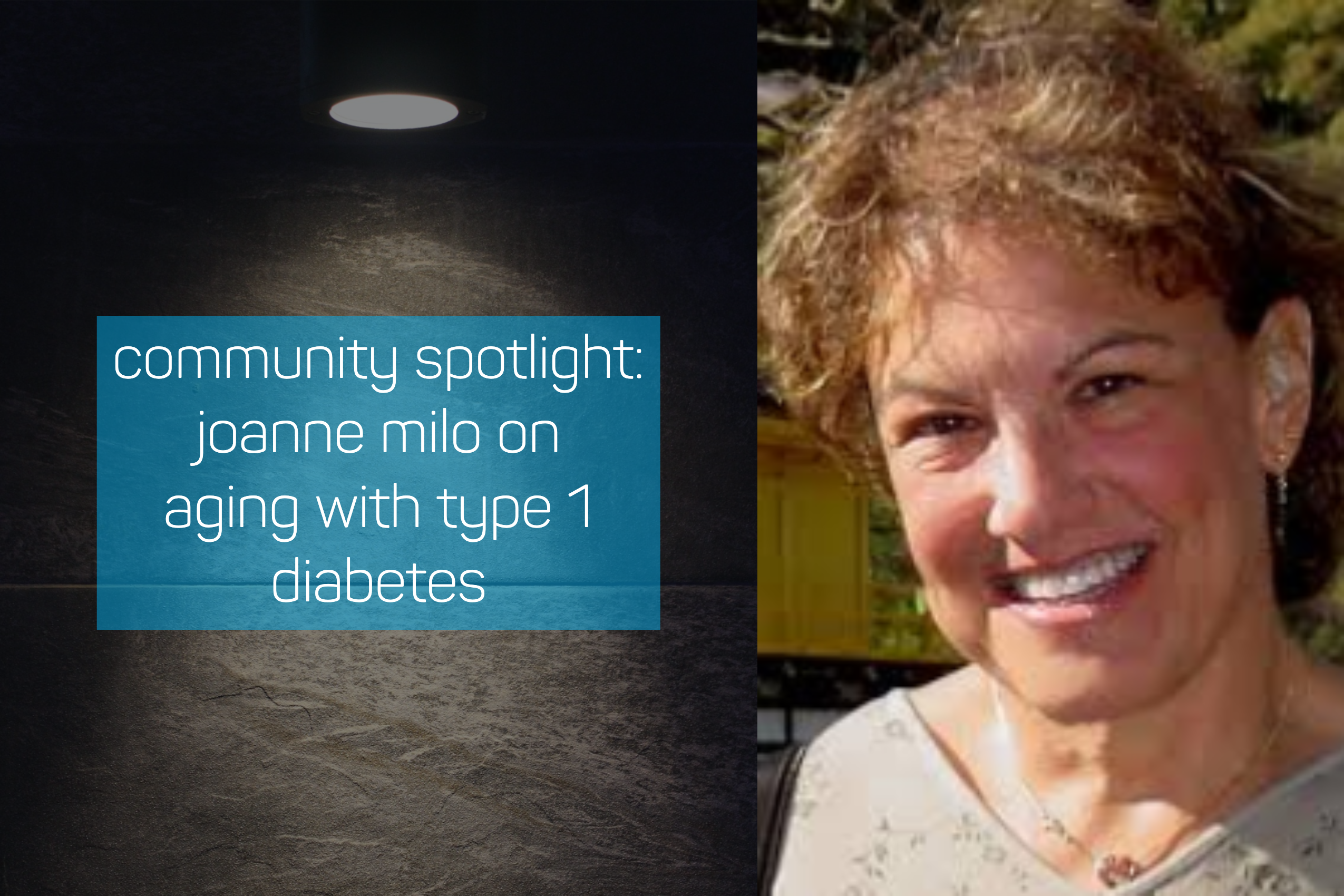This week, during our November celebration of our community, Bigfoot talks with author and advocate Joanne Milo, living with type 1 diabetes for over 50 years. Joanne, known as “The Savvy Diabetic”, has raised over $250,000 for cure research and more recently has become a voice for aging well with insulin-requiring diabetes. We sit down with Joanne to hear a little about her experience with diabetes technology and to learn about the issues she sees impacting long-time T1s.
Bigfoot: You were diagnosed with type 1 diabetes in 1965. Can you tell us about your diagnosis or your early days living with T1D?
Joanne: Just before my 11th birthday, my family was on Christmas vacation in Puerto Rico, and I developed extreme abdominal pains and I couldn’t get enough Coca-Cola to drink. My folks took me to the big city hospital ER, and it was just so scary to me that I refused to give a urine sample. So we were just released, and I continued to be thirsty! Upon returning home and resuming our lives, I would come home from ballet class and drink an entire bottle of orange juice...and yet, I was losing weight. Finally, one morning, I just complained about a severe headache and not feeling well. We saw my pediatrician and he diagnosed diabetes mellitus, at 5:30pm. It all seemed surreal. I remember every detail of that afternoon. He sent us home to get insulin, syringes, and Tes-Tape (for urine glucose testing) and gave us a schedule for insulin injections. My mother monitored me all night between her bouts of crying.
My parents read everything they could, and, looking back, it was supportive and scary. My mom cried a lot. My dad got very involved in making charts for my urine test results and insulin injections. He also became a significant fundraiser to find a cure for his little daughter’s diabetes.
After several months of my parents giving me injections, I took over the task and began to accept the changes in my life. I was compliant in testing my urine, but I often would “cheat” the system (Clinitest) by adding less urine, more water, or shaking the test tube before it was finished just to get “better” results.
One of the earliest blood glucose meters came out in 1970. My parents bought me the Ames EyeTone Reflectance Meter, which cost $450 and was at least more accurate than urine testing. When I went away to college, I carried it with me to my dorm until LifeScan came out with the portable meter! That was an amazing improvement!
Bigfoot: You have a particular focus on issues of long-term type 1 diabetes and aging. What are some of the challenges and care concerns that you wish people better understood?
Joanne: When I was diagnosed in 1965, I was told by a world-renowned endocrinologist that I might not live past age 40. (He also told me that there would be a cure within 2 years!) That was the current thinking and the concept lodged in my brain. Most of us diagnosed back then heard the same forecast. When I turned 41, I felt I had TRIUMPHED! Beat the predictions!
I have now lived with T1D for almost 55 years. I achieved Medicare age. I’m still ALIVE! But here’s the problem/issue:
Fifty years ago, a diagnosis of type 1 diabetes meant a shortened life span. Many of us who were diagnosed as children were told that we would not live past age 40. Insulin was made from animal sources, blood sugars were determined daily by crude urine test measurements, and there was no definitive knowledge of the best course of treatment and standards of care.
But now, because of extensive scientific research and the development of better insulins and advanced technologies such as insulin pumps and continuous glucose monitoring systems, people living with T1D can be expected to live a full and long life, with the caveat of maintaining blood sugars as close to normal as possible. And for those who do develop complications, there are new and exciting therapies that extend our lives, our vision, our kidneys, etc. This is all GOOD NEWS!
Because we are living longer, however, and because we likely lived through those years with less than optimal BG control, we may be dealing with some complications. In addition, we face the issues that often arise with aging, which is now the new complication of T1D, in my opinion.
Indeed, even when diabetes is well-controlled, people with T1D may—and often do—develop aging-related conditions such as cardiovascular disease, kidney disease, neuropathies and loss of sensation, digestive disorders, diabetic retinopathies, chronic inflammation, multiple other autoimmune diseases which require many more medications, significant fatigue, burn-out and depression, and cognitive impairment, often decades ahead of their counterparts who do not have T1D. These additional complications, concomitant conditions, increased vulnerability to stressors, and changes in physical abilities all contribute to a strain on their quality of life and, indeed, life expectancy. Add to this the considerations of financial concerns (costs of insurance, medications, and caregiving), and you can readily see the problem. The health needs of the increasing number of Americans with T1D who are reaching older ages are becoming overwhelming, frightening, and a significant public health issue.
We are an emerging demographic—aging T1Ds—and our numbers are swelling! When I first went to the Joslin Clinic in Boston as a teenager (spent every Christmas holiday at the clinic...oh, how I hated that), Joslin was offering a gold watch to those of us who survived 50 years with T1D. When I hit my 50 year mark, I got a brass paperweight! When I asked where my gold watch was, I was told that too many of us are living to that threshold!
Of the approximately 1.25 million Americans living with T1D, it is estimated that about 200,000 are under the age of 20. That means, over 1 million are OVER age 20...and having birthdays!!!
Specifically, our concerns include:
- Self-care and integrating new technologies
- Developing an advocate network for daily health issues and in-hospital care
- Managing a multitude of complications and medications
- Continued coping and fatigue and burnout
- Financial burdens
- Long term SAFE care and the ability to maintain or transition away from technology
Bigfoot: Can you tell us about the conversations your support group is having and the work you’re doing on this front?
Joanne: I’ve organized a working group of 10-12 long term people with T1D who are equally aware and passionate about addressing these issues. We’re developing a clearer problem statement and a set of potential solutions. I’ve been meeting with a local hospital team who have expressed concern and interest in our research. And I’ve reached out to a few key folks in the T1D community on how best to “sound the alarm” and develop solutions.
I feel a huge sense of urgency. I run a support group with over 100 people with T1D. Actually, I consider it as more of a network of adults with T1D in my county. Most are articulate and proactive. We meet irregularly, but I communicate with them actively. I also offer a subset who receive a bi-weekly email that is just an encouraging email...seems to help a whole lot! I’d love to do this on a large scale.
Bigfoot: As a diabetes technology company, we’re interested in how we can help people use technology for their diabetes when they might not traditionally use or have had access to it. What do you think people who’ve lived for decades with T1D want and need from their diabetes tools? What should diabetes device companies keep in mind in designing for this population?
Joanne: I’ve been on a do-it-yourself automated insulin delivery system for almost 3 years, and, at times, I just get tired of the updates and trying to stay current. I want the flexibility to use the best and most customizable solutions, but after holding our second SoCal Loopers meeting in Orange County, CA last month (over 30 people including 18 people with T1D), I see the stress of the DIY tech.
I think what we want, or at least, what I want, are the best solutions, but shielded from the technology. One of the most challenging things for me is settings—basals, ISF (insulin sensitivity factor), Insulin-to-Carb ratios, DIA (duration of insulin action), etc. Just as I don’t care about the gas/air ratio in my car, I want to be able to just take my D-tech to a Diabetes Auto Mechanic! I want to have it run through an expert analysis and get recommendations to use better settings.
If diabetes tech involves personalization (which it really has to), please include the very best consulting so that people with insulin-requiring diabetes can use the tech right out of the box, without having to find a Certified Diabetes Educator (CDE) who has specialized understanding.
Bigfoot: Do you have any advice for people who share your concerns about aging and living well with long-term insulin-requiring diabetes?
Joanne: YES! What we are working on are some crib sheets to:
- Identify and educate our advocates (not always a spouse and not only a spouse, since spouse might not be available to help in an emergency, need backup)
- As exactly as possible, an instruction sheet with “How I Manage my Diabetes”, including friends with diabetes who can be on stand-by for calls from advocates
- Keep a Personal Medical Resume (All about Me)
Thanks for sharing your perspective with Bigfoot, Joanne! We wish you and your support group the best of success in sharing your message. If you’d like to hear more from Joanne Milo, you can check out her blog at The Savvy Diabetic.


